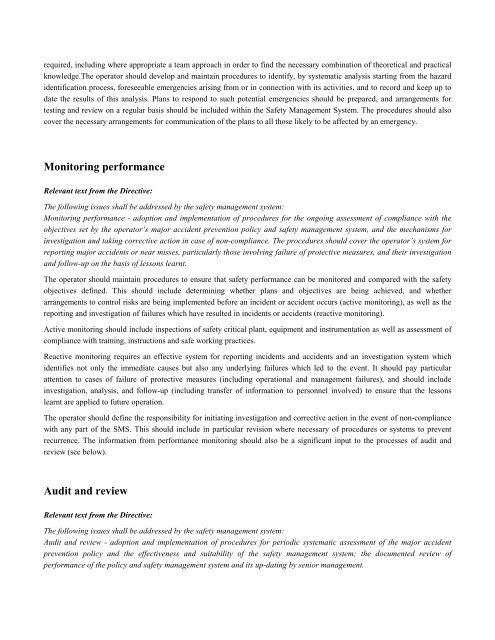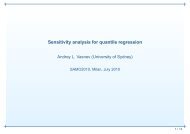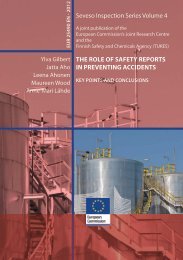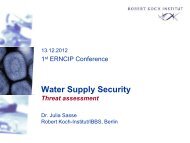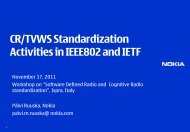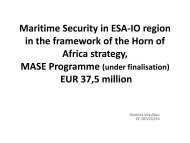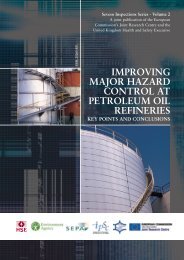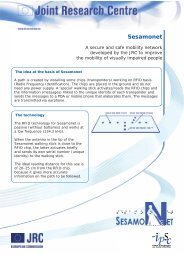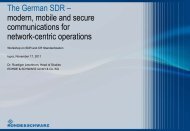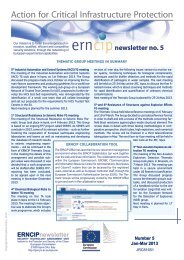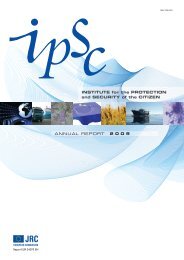Guidelines on a Major Accident Prevention Policy and Safety ... - IPSC
Guidelines on a Major Accident Prevention Policy and Safety ... - IPSC
Guidelines on a Major Accident Prevention Policy and Safety ... - IPSC
You also want an ePaper? Increase the reach of your titles
YUMPU automatically turns print PDFs into web optimized ePapers that Google loves.
equired, including where appropriate a team approach in order to find the necessary combinati<strong>on</strong> of theoretical <strong>and</strong> practical<br />
knowledge.The operator should develop <strong>and</strong> maintain procedures to identify, by systematic analysis starting from the hazard<br />
identificati<strong>on</strong> process, foreseeable emergencies arising from or in c<strong>on</strong>necti<strong>on</strong> with its activities, <strong>and</strong> to record <strong>and</strong> keep up to<br />
date the results of this analysis. Plans to resp<strong>on</strong>d to such potential emergencies should be prepared, <strong>and</strong> arrangements for<br />
testing <strong>and</strong> review <strong>on</strong> a regular basis should be included within the <strong>Safety</strong> Management System. The procedures should also<br />
cover the necessary arrangements for communicati<strong>on</strong> of the plans to all those likely to be affected by an emergency.<br />
M<strong>on</strong>itoring performance<br />
Relevant text from the Directive:<br />
The following issues shall be addressed by the safety management system:<br />
M<strong>on</strong>itoring performance - adopti<strong>on</strong> <strong>and</strong> implementati<strong>on</strong> of procedures for the <strong>on</strong>going assessment of compliance with the<br />
objectives set by the operator’s major accident preventi<strong>on</strong> policy <strong>and</strong> safety management system, <strong>and</strong> the mechanisms for<br />
investigati<strong>on</strong> <strong>and</strong> taking corrective acti<strong>on</strong> in case of n<strong>on</strong>-compliance. The procedures should cover the operator’s system for<br />
reporting major accidents or near misses, particularly those involving failure of protective measures, <strong>and</strong> their investigati<strong>on</strong><br />
<strong>and</strong> follow-up <strong>on</strong> the basis of less<strong>on</strong>s learnt.<br />
The operator should maintain procedures to ensure that safety performance can be m<strong>on</strong>itored <strong>and</strong> compared with the safety<br />
objectives defined. This should include determining whether plans <strong>and</strong> objectives are being achieved, <strong>and</strong> whether<br />
arrangements to c<strong>on</strong>trol risks are being implemented before an incident or accident occurs (active m<strong>on</strong>itoring), as well as the<br />
reporting <strong>and</strong> investigati<strong>on</strong> of failures which have resulted in incidents or accidents (reactive m<strong>on</strong>itoring).<br />
Active m<strong>on</strong>itoring should include inspecti<strong>on</strong>s of safety critical plant, equipment <strong>and</strong> instrumentati<strong>on</strong> as well as assessment of<br />
compliance with training, instructi<strong>on</strong>s <strong>and</strong> safe working practices.<br />
Reactive m<strong>on</strong>itoring requires an effective system for reporting incidents <strong>and</strong> accidents <strong>and</strong> an investigati<strong>on</strong> system which<br />
identifies not <strong>on</strong>ly the immediate causes but also any underlying failures which led to the event. It should pay particular<br />
attenti<strong>on</strong> to cases of failure of protective measures (including operati<strong>on</strong>al <strong>and</strong> management failures), <strong>and</strong> should include<br />
investigati<strong>on</strong>, analysis, <strong>and</strong> follow-up (including transfer of informati<strong>on</strong> to pers<strong>on</strong>nel involved) to ensure that the less<strong>on</strong>s<br />
learnt are applied to future operati<strong>on</strong>.<br />
The operator should define the resp<strong>on</strong>sibility for initiating investigati<strong>on</strong> <strong>and</strong> corrective acti<strong>on</strong> in the event of n<strong>on</strong>-compliance<br />
with any part of the SMS. This should include in particular revisi<strong>on</strong> where necessary of procedures or systems to prevent<br />
recurrence. The informati<strong>on</strong> from performance m<strong>on</strong>itoring should also be a significant input to the processes of audit <strong>and</strong><br />
review (see below).<br />
Audit <strong>and</strong> review<br />
Relevant text from the Directive:<br />
The following issues shall be addressed by the safety management system:<br />
Audit <strong>and</strong> review - adopti<strong>on</strong> <strong>and</strong> implementati<strong>on</strong> of procedures for periodic systematic assessment of the major accident<br />
preventi<strong>on</strong> policy <strong>and</strong> the effectiveness <strong>and</strong> suitability of the safety management system; the documented review of<br />
performance of the policy <strong>and</strong> safety management system <strong>and</strong> its up-dating by senior management.


